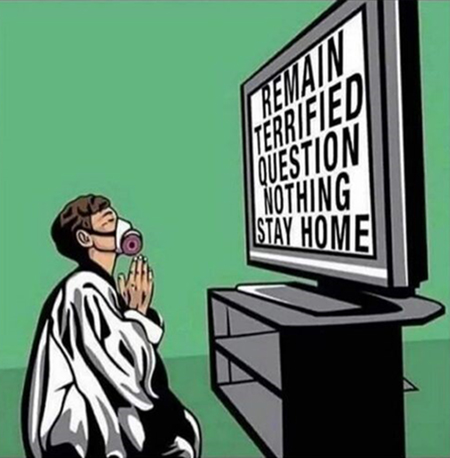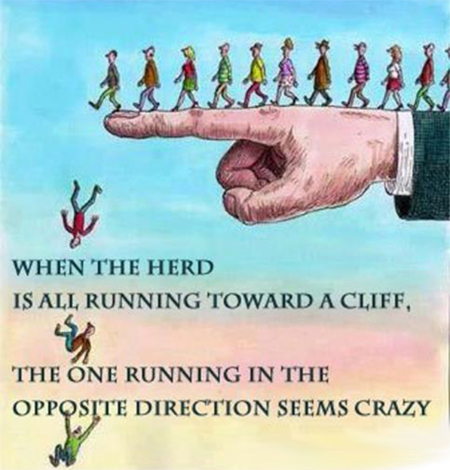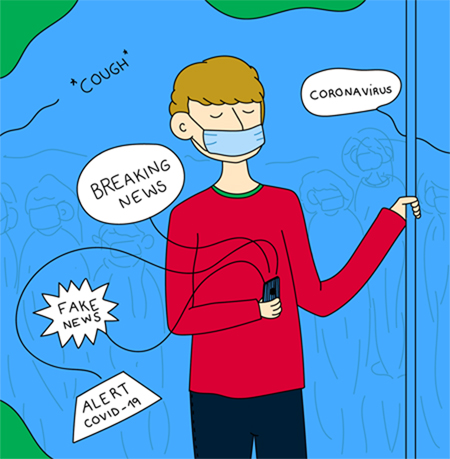On escaping viral entrancement
By John Waters
(alternative media journalist)
There is an ancient principle of the common law, whereby it is held that the people may do everything except that which they have expressly forbidden, and the state may do nothing except that which the people have expressly permitted. How did this principle come to be unstitched and reversed in the past months? How did the people come to agree to its reversal?

In search of answers, I have been reflecting a lot on a phrase I transcribed into a notebook years ago from Martin Amis’s Koba the Dread: “…a contagion of selective incuriosity, a mindgame begun in self-hypnosis and maintained by mass hysteria.”
While not discounting the impact of short-term welfare payments (buying the people’s freedom with their own money) I have gotten to thinking that the answer maybe includes, as a primary factor, something along the lines of mass hypnosis — the viral entrancement of entire populations.
The process at work is somewhat different to the use of hypnotic or “spell” phrases to herd individuals into a particular way of, for example, politically correct thinking. As the late Roger Scruton described it, spell words like “racist” and “homophobe” are designed to invoke a set of pre-programed demonic tags with which to threaten the subject and dissuade him from truth and common sense. When these words are uttered, the object is as though stung by a cattle prod or electric fence, thus experiencing a kind of mortification which, in the vast majority of cases, is sufficient to cause an immediate falling into line. The process used in the herding of individuals into the mass is correlated but subtly different. The method here is not to repel by a shock but to seduce by means of evocative or empathetic words.
Like any form of hypnosis, mass entrancement depends on the leveraging of several inter-related conditions in the subject: focused attention, including impaired or reduced peripheral awareness; an imaginative state — these contributing to vastly increased suggestibility. The COVID-19 scare and accompanying lockdowns enabled these criteria to be met almost everywhere. The attention of audience-members being focused on one topic, many unconsciously acquired a heightened capacity to absorb even the most unusual and presumptuous messages without blinking.
Imagination is a key tool of the hypnotist. With an appropriate script and slipping into mimicry of well-remembered charismatic leaders of the past — a touch of Kennedy, a soupcon of Churchill — even the most plank-like politician can affect a sufficiency of charisma or gravitas to seduce his audience into the zone where he can present them with word-pictures and teleport them to a place of collective imagining. A mood of siege or crisis is sufficient to inveigle even citizens who yesterday saw the plank for what it was to succumb also to his spell.
By affecting empathy, rapport, a sense of common purpose, he guides his subjects towards the desired frame-of-consciousness. He seeks access to the unconscious, but not that of the individual person; rather, he wishes to remove each member of his audience to a common place: the herd mind in which he knows they can all come to share approximately the same outlooks, so that henceforth they can be summoned to that place by signs and triggers without leaving their armchairs.
TV creates an ideal medium via which to conduct this form of hypnosis, not least because the news comes sandwiched between movies and soap operas which engage the imaginative and emotional elements of the mind. These, maintained by fictionalised versions of reality, provide the heightened state that renders the subject amenable to be lured into a kind of trance. Once achieved, the trance can be reactivated at will in anyone whose attention, primed on fictional narratives, remains in this state of focused imaginative attention, being highly prone to easy emotional arousal. The purpose is to tap into that part of the subconscious dealing with emotions. When in a self-induced trance, in the grip of rage, hatred, fear, anxiety, sadness, worry, envy, greed, selfishness, humans tend to become cut off from their thinking brains and thereby susceptible to adopting a locked-in, limited view of reality. In the lockdown episode, fear has been the chief emotional trigger imposed by the controllers to be manipulated to further the entrancement process.
Despite having a degree of understanding of this, I am not totally immune. My daughter sends me on WhatsApp a photograph she’s taken out on a morning walk in our beloved Sligo, in the West. It’s of a tiny lockdown shrine left by some surfers, clusters of rocks on a wall near the cliffs at Lislary, painted in rainbow colours and bearing legends like: “We are all in this together”; “Be kind”; “Keep smiling”. For a moment my resolve and reason go into collapse. Longing to be there, I long also to belong.
French psychologist Gustave Le Bon, in The Psychology of Crowds, explained that a crowd has a different psychology to that of an individual. Le Bon was the first to treat of “psychological crowds”, which he diagnosed as forming a single being, responding always to unconscious thoughts, and conforming to laws of consciousness unity.

The consciousness bestowed by membership of a crowd can be transformative of the person, putting individual members in possession of “a sort of collective consciousness which makes them feel, think and act in a manner quite differently from that in which each individual would feel, think and act were that person in a state of isolation.” In a psychological crowd, individual personality disappears, brain activity is replaced by reflex activity, a lowering of intelligence, provoking a complete transformation of sentiments, which may be better or worse than those of the crowd’s constituent members. A crowd may just as easily become heroic or criminal. “The ascendency of crowds,” wrote Le Bon, “indicates the death throes of a civilization.” The upward climb to civilization is an intellectual process driven by individuals; the descent is a herd in stampede. “Crowds are only useful for destruction.”
A paradox, then, of the lockdown state: in isolation, using electronic means, it is easier to convert the individual to the collective mindset than if he were a member of an actual physical crowd. Le Bon goes on:
“There are certain ideas and feelings which neither come into being, nor transform themselves into acts, except in the case of individuals forming a crowd. The psychological crowd is a provisional being, formed of heterogeneous elements which for a moment are combined, exactly as the cells which constituted a living body form by reunion a new being which displays characteristics very different from each of the cells singularly.”
A hypnotherapist friend tells me of the three phases in creating a hypnotic state: “Idealization”, “Devaluation”, and “Alienation”.
The first phase, “Idealization”, can also be called “love-bombing”: when the controller/hypnotist strives to identify with and mirror the target individual or social group. He thanks the people for their stoicism thus far, praises them, and reminds them they are “saving lives” then spells out the next stage of the lockdown.
The “perpetrator” in this case is the state/government/president/governor, but also — and more continuously — the media, exerting power in order to manipulate and control using the weapons of fear, guilt and obligation, which impress the presence of constant danger on the reptilian lower brain, ensuring widespread compliance.
All fears converge in one: fear of death. On the pathways in the parks near my home are intermittently placed chalk figures separated by arrows pointing at each figure, indicating the extent of two meters, designed to evoke the chalk marks investigators draw around the corpse of a murder victim. Statistics of deaths, most of them invented or inflated — are rolled out by the hour. Terms like “deadly virus” are used non-stop: The phrase “new normal” has the effect of insinuating the loss of things long cherished, a state of bereavement, characterised by sadness. The applauding by candlelight of “front line” workers is a way of compelling holdouts to throw themselves into the spell, an almost literal form of gas-lighting in which we are required to celebrate our own loss of freedom.
The reptilian non-brain responds to repetition — of words and phrases, memes, catchwords, clichés, which serve to embed the hypnotic suggestions to the extent that they became beliefs, thus immune to rational argumentation. Physical triggers can be more efficient than verbal ones, especially if self-administered, creating an instant pavlovian effect.
Ritual is a key factor in the alteration of expectations, which in turn transforms reality. Rituals are process of initiation and renewal, which reinforce beliefs, behaviors, and values, inducing conformity, groupthink, accommodation to changes in structures, a reinvented sense of belonging. They are transformative, redefining, rebirthing.
In the course of the “pandemic”, the mask has emerged as a new symbol of pseudo-solidarity, though really it is an instrument of fear-mongering and alienating. The more threadbare the COVID-19 story became, the more people seemed to be wearing them, not so much as precautionary apparel as a form of accusation: You are threatening my life! The rituals anchor the subject in his situation. The mask provokes a death of the old self, enabling a new self to be born: the temporary covering of the old face while the new one is immersed in the period of gestation necessitated by the transformation. Once the mask is donned, the subject becomes his more fearful self. Washing of hands has a similar effect, but also gives a renewed sense of security. In both cases, the mood of the subject is changed by the action: going outdoors awhile and returning with a sense of relief to the decontaminating ritual of hand-washing, dividing his reality in psychological as well as physical terms.

Rituals work subliminally to alter perception, to strengthen or exaggerate existing emotions, like an acupuncture of the mind. The initiate in a religious rite is separated from reality and, in advance of the ritual, placed in isolation so as to become decontaminated from everyday influences: Shelter-in-place involves a form of detoxification from the logic, desires, assumptions and language of the world, a process of renouncing that facilitates a coming to terms with losses about to be imposed as part of the initiation: loss of freedom, loved ones, hopes, expectations.
A transition follows: the subject begins to let go of everything she has taken for granted, prepares to enter a new regime, to cross the threshold to a new era. A new mood descends, a mixture of fear and sorrow, accompanied by an escalating sense of powerlessness that threatens to overwhelm until the subject agrees to accept. Then comes the liberation and release that accompany the signing away of freedom for an insinuated higher purpose. This is akin to the liminal state between life and death. The old life is subjected to a form of scorched earth, presaging a surrender to the new normal.
By persuading people to engage in rituals — essentially collective rites and ceremonies they would not normally succumb to while alone, it is possible to draw them into an imagined herd for the purpose of imbuing them with collective thoughts, breaking with existing or normative patterns of thought and behaviour. Using repetition and emotional enhancement, the ritual imposes a new language, new signposts, contained in words and symbols. Ritual operates to impose new codes as a way of effecting changes in thinking, working primarily at the spiritual and psychological levels, but unnoticed as such. It serves to suspend the cognitive dimension, thus eliminating any individual reservations that might otherwise manifest as embarrassment, while activating elements of the mind not usually engaged. The subject is both actor and spectator.
The second phase, “Devaluation”, is analogous to the live cooking of a frog. Words of praise and consolation are juxtaposed with house arrest, a form of Stockholm syndrome. Images and ideas of restriction, control, humiliation, are packaged in sentimental forms of manipulation: nurses dancing amidst what we are led to presume are unremitting scenes of death; grandchildren waving to their heartbroken grandparents through a wound-up car window. The glass becomes a symbol of the invisible wall that may permanently separate them, the “new normal” thus far merely announced but part of the dread that is insinuated concerning an unknowable future. Generated confusion, mixed messages, are central elements: you must be sure to take care of old people — just don’t go near lest you kill them; it is important to become infected to achieve immunity but at all costs avoid infecting other healthy people; wear a mask, even though “experts” say they are ineffective. This incoherence destabilizes the sensibility of the subject, rendering him amenable to further manipulation. Since he cannot understand, he simply obeys.
Then comes the final phase of the hypnosis: “Alienation”, the iron fist. No more Mr. Nice Guy. The police, it turns out, have been issued with more equipment, more vehicles, more guns, more batons, Rottweiler-shaped robots to spy on the public. Reinforcements are brought in, including trainees, part of the process of abasement. This is where the real motives may more readily be seen. Our rights having been stripped away, we begin to awake to the folly of thinking of the controllers as our savours or guardians.
My hypnotherapist friend explains that, in order to maintain the control, a method of what known as “intermittent reinforcement” takes place, whereby the tone of the controllers becomes more austere and threatening, establishing another layer of conditions in respect of the future. Unless compliance improves, we are warned, the ante may have to be increased. We should not expect a return to normal any time soon — or at all. The “second wave” is mentioned in tones of disappointed rebuke, setting up an expectation that failure to meet the contradictory requirements may result in further coercion.
“With each intermittent reinforcement there will be a further erosion of civil liberties and so the program goes on…” My friend speaks also of “bread-crumbing”, whereby the controller further undermines, devalues, and denigrates his targets. This concept derives from the idea of the subject of a romantic crush, who though not reciprocating the feelings of the entranced person, nevertheless flirts a little, perhaps by sending occasional signs (breadcrumbs to hungry birds) so the attention does not dissipate. When the subject discerns the patterns of manipulation, control and abuse, his sense of the benign intent of the controller dissolves and foul play becomes more apparent. If feedback indicates that the populace is beginning to wake up to the deception and manipulation, the controller must show that he is indeed working for everybody’s good by intermittently appearing to be on their side. This registers in the entranced individual as a chemical rush of serotonin, oxytocin and other chemicals of relief, which facilitate the deepening of the stranglehold.
If any of this rings a bell, the first thing to do is turn off the TV. The sole way of achieving immunity to mass hypnosis is through the development of awareness of the technique, which involves the constant application of reason. But first we need to reclaim our consciousness from the controllers, and return it to their rightful owners, who must endure a period of abstinence before returning to sobriety. And then we need to take urgent steps to ensure that nothing like this can ever occur again.
yogaesoteric
October 20, 2020
